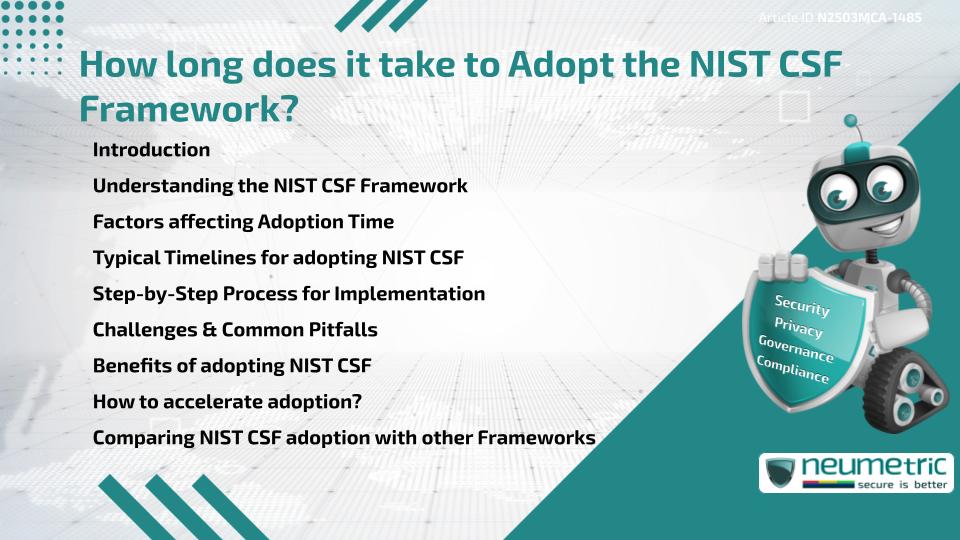Table of Contents
ToggleHow long does it take to Adopt the NIST CSF Framework?Introduction
Adopting the National Institute of Standards & Technology Cybersecurity Framework [NIST CSF] is a crucial step for Organisations aiming to enhance their Cybersecurity Posture. However, one of the most common questions Organisations ask is: How long does it take to Adopt the NIST CSF Framework? The answer depends on multiple factors, including the Organisation’s size, existing Security Measures & available Resources. This article provides a detailed breakdown of the adoption process, expected timelines & key challenges organisations may face.
Understanding the NIST CSF Framework
The NIST CSF is a Voluntary Framework designed to help Organisations manage & reduce Cybersecurity Risks. It consists of five (5) core functions: Identify, Protect, Detect, Respond & Recover. These functions provide a structured approach to Cybersecurity, helping Organisations build resilience against Cyber Threats.
Factors affecting Adoption Time
Several factors influence how long does it take to Adopt the NIST CSF Framework, including:
- Organisation size: Larger Organisations with complex infrastructures may take longer.
- Existing Cybersecurity Maturity: Businesses with well-established Security Measures can integrate NIST CSF faster.
- Resource availability: Adequate Personnel, Tools & Funding can significantly speed up adoption.
- Compliance Requirements: Organisations subject to Regulatory Mandates may need additional time to align their Policies.
Typical Timelines for adopting NIST CSF
While every organisation is different, typical adoption times can be categorised as follows:
- Small Businesses: Three (3) to six (6) months
- Medium-sized Enterprises: Six (6) to twelve (12) months
- Large Enterprises: Twelve (12) to twenty-four (24) months
These estimates vary based on how well an Organisation aligns with the NIST CSF Guidelines before starting the adoption process.
Step-by-Step Process for Implementation
- Assessment: Evaluate current Cybersecurity Practices against the NIST CSF.
- Gap analysis: Identify gaps between existing Security Measures & NIST CSF Requirements.
- Prioritisation: Develop a Roadmap focusing on High-Priority Areas.
- Implementation: Deploy the necessary Policies, Tools & Controls.
- Monitoring & improvement: Continuously assess & refine Security Practices.
Challenges & Common Pitfalls
Organisations often face obstacles when adopting the NIST CSF, including:
- Lack of Expertise: Understanding NIST CSF Requirements can be complex for some teams.
- Budget constraints: Financial limitations may slow down implementation.
- Resistance to Change: Employees &Leadership may be reluctant to adjust existing processes.
- Integration difficulties: Aligning NIST CSF with existing Security Programs can be challenging.
Benefits of adopting NIST CSF
Despite the challenges, the advantages of NIST CSF adoption include:
- Improved Cybersecurity Posture: Enhanced protection against Cyber Threats.
- Regulatory alignment: Simplifies Compliance with Security Regulations.
- Risk Management: A structured approach to identifying & mitigating risks.
- Stakeholder confidence: Increased trust from Customers, Partners & Regulators.
How to accelerate adoption?
Organisations can shorten the Adoption timeline by:
- Leveraging external expertise: Consulting Cybersecurity Professionals can provide valuable guidance.
- Utilising Automation Tools: Security Automation can speed up implementation.
- Training Employees: Educating Staff ensures a smoother transition.
- Setting Realistic Goals: Breaking the process into manageable phases improves efficiency.
Comparing NIST CSF adoption with other Frameworks
Compared to Frameworks like ISO 27001 & SOC 2, the NIST CSF is more flexible & can be adopted incrementally. However, Organisations requiring formal Certification may prefer ISO 27001 or SOC 2, which have more rigid Compliance Requirements.
Takeaways
- How long does it take to Adopt the NIST CSF Framework? The answer depends on Organisational size, Security Maturity & Resources.
- Typical adoption timelines range from three (3) months to two (2) years.
- Key challenges include Budget constraints, Expertise gaps & resistance to Change.
- Benefits include improved Cybersecurity, Regulatory Alignment & enhanced Risk Management.
- Organisations can speed up adoption by leveraging Expertise, Automation & Employee Training.
FAQ
How long does it take to Adopt the NIST CSF Framework in a Small Business?
Small Businesses typically take three (3) to six (6) months, depending on their existing Security Practices & Resources.
How does NIST CSF compare to ISO 27001 in terms of Adoption Time?
NIST CSF is more flexible & can be adopted incrementally, whereas ISO 27001 requires formal Certification, making its adoption longer & more resource-intensive.
Can a Company adopt only parts of the NIST CSF Framework?
Yes, Organisations can adopt NIST CSF in phases, focusing on priority areas first before full implementation.
What are the biggest challenges in adopting NIST CSF?
Common challenges include a lack of Expertise, Budget constraints, resistance to Change & Integration difficulties.
Does adopting NIST CSF guarantee Compliance with regulations?
While NIST CSF improves Cybersecurity, it does not provide Regulatory Certification but can help align with Compliance Requirements.
How can Organisations accelerate NIST CSF adoption?
By leveraging External Expertise, using Automation Tools, Training Employees & Setting clear, realistic Goals.
What Industries benefit the most from NIST CSF adoption?
Industries handling Sensitive Data, such as Finance, Healthcare & Government, benefit significantly from adopting the NIST CSF.
Is NIST CSF adoption mandatory?
No, it is a Voluntary Framework, but many Organisations adopt it to strengthen their Cybersecurity Posture & meet Regulatory Expectations.
How often should Organisations update their NIST CSF implementation?
Organisations should review & update their NIST CSF implementation regularly to address emerging Cyber Threats & evolving Risks.
Need help?
Neumetric provides organisations the necessary help to achieve their Cybersecurity, Compliance, Governance, Privacy, Certifications & Pentesting goals.
Organisations & Businesses, specifically those which provide SaaS & AI Solutions, usually need a Cybersecurity Partner for meeting & maintaining the ongoing Security & Privacy needs & requirements of their Clients & Customers.
SOC 2, ISO 27001, NIST, HIPAA, HECVAT, EU GDPR are some of the Frameworks that are served by Fusion – a centralised, automated, AI-enabled SaaS Solution provided by Neumetric.
Reach out to us!




